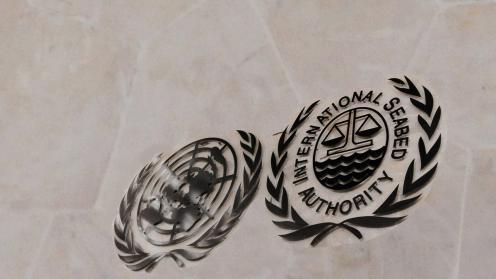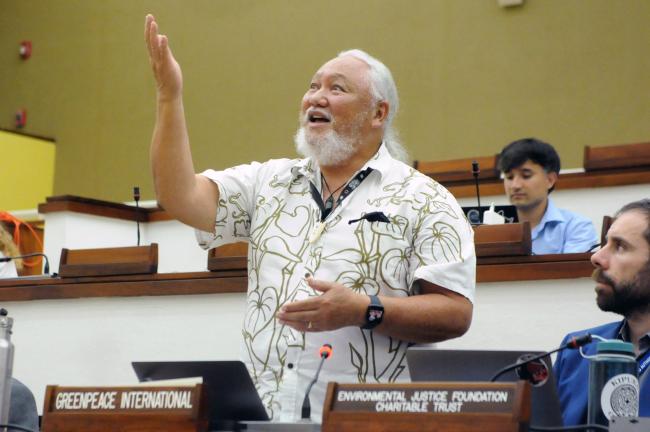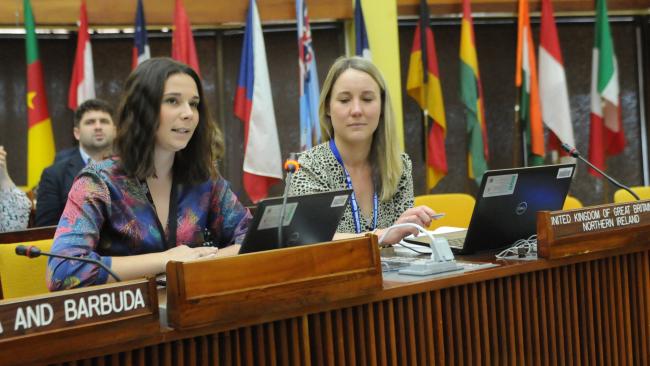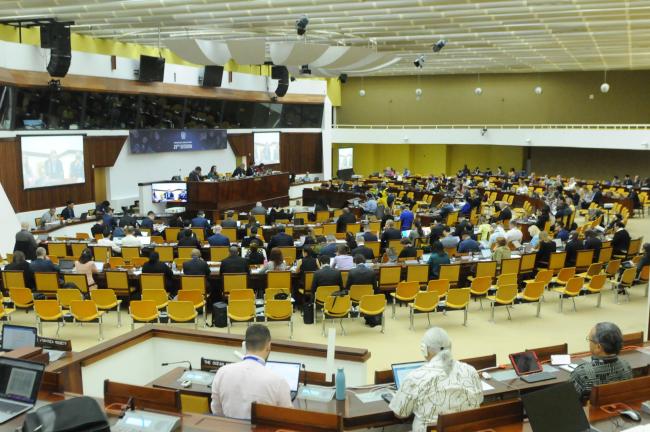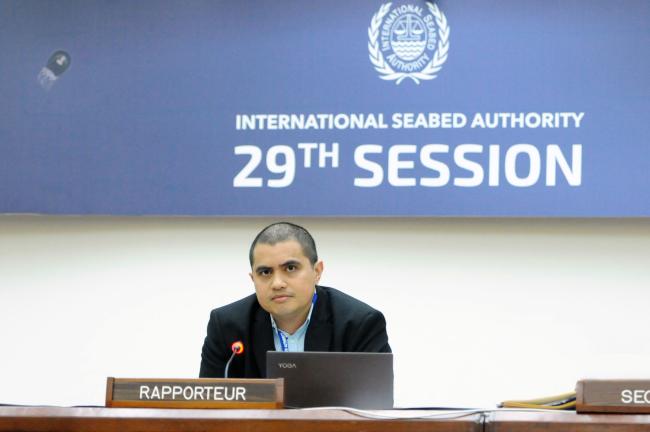The need to ensure the protection and preservation of the marine environment from negative impacts of deep-sea mining dominated the day’s discussions. International Seabed Authority (ISA) members focused on the environment impact assessment (EIA) process, regional environmental management plans (REMPs), and test mining, all of which are integral building blocks of a robust regime for environmental protection. In the afternoon, a thematic discussion shed light on intangible aspects of underwater cultural heritage (UCH).
In the morning, Raijeli Taga, Fiji, invited delegates to discuss the EIA process on the basis of the briefing paper on conceptual topics related to environmental matters.
The UK, on behalf of the coordinators of the intersessional work to streamline the structure of the EIA provisions, outlined the outcomes of their work. She explained the proposed new structure, which includes developing a regulation for each procedural step of the EIA process, and placing supplementary provisions and details under annexes, standards, and guidelines, as appropriate. Most members supported the outcome as a basis for further discussion.
Members then focused on the relevant draft regulations, particularly the EIA process (Regulation 46). Many noted that the provisions on the scoping report (Regulation 47 bis) should precede the one on the EIA process. Some members stressed that certain requirements of the UN Treaty on Biodiversity of Areas Beyond National Jurisdiction (BBNJ Treaty) should also be reflected in the draft regulations, ensuring a consistent approach. The intersessional working group will continue its work on restructuring the provisions.
Facilitator Taga then invited delegates to focus on REMPs, particularly how the environmental management and monitoring plan (EMMP) and the environmental management system (EMS) should be coordinated with the relevant REMP as well as related legal consequences.
Many delegates highlighted the importance of REMPs, including as a basis for each contractors’ EMMP and EMS. Many also stressed that REMPs should be in place before assessing an application for a plan of work. Some members underscored that REMPs are environmental policy instruments, stressing the need to guarantee flexibility, adaptability, and effectiveness.
Delegates further discussed: the relationship between REMPs, EMMPs, and ISA’s environmental objectives and goals; REMPs as the basis for developing a plan of work; and the designation of no-mining areas and areas of particular environmental interest under REMPs, restricting activities.
Regarding the legal status of REMPs, some delegates stressed that REMPs requirements should be binding to fulfil UN Convention on the Law of the Sea (UNCLOS)-related obligations. A regional group stressed that REMPs requirements can be incorporated into exploitation contracts. Some delegates suggested making compliance with REMPs a condition for an exploitation contract. Another proposed using the Council or Assembly to approve REMPs, rather than the Legal and Technical Commission (LTC), to give them legal effect. A few delegates noted that REMPs are useful tools to protect the marine environment but have no legal standing.
In the afternoon, Facilitator Taga invited delegates to focus on test mining. Germany presented the report on the outcomes of intersessional work, focusing on how test mining fits with exploration and exploitation, and the concept of a validation monitoring system. He noted that consensus is still distant and further discussions will be required.
Many members noted that test mining is itself an activity in the Area and should be carried out under an exploitation or exploration contract. Many further stressed that test mining should be subject to an EIA.
Delegates stressed that test mining assists in better understanding marine ecosystems and associated risks of human activities. Some cautioned that small-scale test mining cannot provide the necessary data, including on environmental impacts. Members expressed divergent positions on whether test mining should be addressed under the exploitation or exploration contract, with many supporting the latter. Many supported conducting test mining prior to approval of a plan of work, noting results should inform the development of the plan of work and the EIA. A member suggested allowing applicants to choose when to conduct test mining. Another suggested developing guidelines for a standardized process.
A delegate stressed that important future questions include whether: a test mining requirement during exploration should be explicitly included in the exploitation regulations; the exploration regulations will need to be amended to reflect this requirement; and test mining may be required before a plan of work, but not as part of exploration.
A thematic discussion ensued on UCH, facilitated by Clement Yow Mulalap, Federated States of Micronesia. Mulalap presented the briefing note, drawing attention to intersessional work focusing on tangible and intangible UCH. He noted further work is needed on intangible UCH, including a relevant definition.
A member suggested addressing intangible UCH elements through the establishment of protected areas with cultural interests, encouraging Indigenous Peoples and local communities to notify the ISA on the existence of such UCH.
Some members noted that the intangible UCH definition provided in the UN Educational, Scientific and Cultural Organization (UNESCO) 2001 Convention on the Protection of UCH is a good starting point for further discussion. A delegate questioned whether the regulations should address issues of UCH at all, pointing out that UNCLOS Article 149 (archaeological and historical objects) refers to “objects of an archaeological and historical nature found in the area.”
Observers highlighted the cultural significance of intangible UCH, stressing it includes traditional knowledge, customs, rituals, languages, stories, oral histories, navigation techniques, traditional fishing practices, spiritual beliefs associated with the marine environment, and other aspects of culture that are deeply tied to a community or place.
To receive free coverage of global environmental events delivered to your inbox, subscribe to the ENB Update newsletter.
All ENB photos are free to use with attribution. For the 1st Part of the 29th Annual Session of the ISA, please use: Photo by IISD/ENB - Diego Noguera
Working Group on the Protection and Preservation of the Marine Environment

Critters actively oversee the discussions on the protection and preservation of the marine environment.

(L-R) Corey McLachlan, Nauru Ocean Resource Inc. (NORI), with Beatrice Chen and Charisse Lau, Singapore
